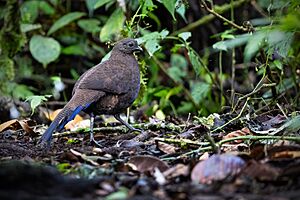Bronze-tailed peacock-pheasant facts for kids
The bronze-tailed peacock-pheasant is a cool bird from Indonesia. It's also called the Sumatran peacock-pheasant. Its scientific name is Polyplectron chalcurum.
Quick facts for kids Bronze-tailed peacock-pheasant |
|
|---|---|
 |
|
| Conservation status | |
| Scientific classification | |
| Genus: |
Polyplectron
|
| Species: |
chalcurum
|
| Subspecies | |
|
|
| Synonyms | |
|
Chalcurus chalcurus |
|
Contents
About the Bronze-tailed Peacock-Pheasant
This bird is a type of pheasant. It is usually dark brown and can grow up to 56 centimeters (about 22 inches) long. It has dark grey legs and a rather small head. Its tail is long and narrow, made of sixteen feathers. These tail feathers are chestnut brown with shiny purplish stripes near the ends.
Both male and female bronze-tailed peacock-pheasants look quite similar. However, the male has a longer tail and two spurs on its legs. A male's eyes are yellow, while a female's eyes are dark brown and she does not have spurs.
Where They Live
The bronze-tailed peacock-pheasant lives only in Indonesia. You can find them in the mountain forests of western Sumatra. This means they are an endemic species, found nowhere else in the world!
Family Tree
This bird belongs to the Phasianidae family, which includes many types of pheasants. It is part of the Polyplectron group, also known as peacock-pheasants. There are seven different species in this group.
There are two main types, or subspecies, of the bronze-tailed peacock-pheasant:
- P. c. chalcurum: This one was first described in 1831. It is known as the southern bronze-tailed peacock-pheasant.
- P. c. scutulatum: This one was described in 1941. It is known as the northern bronze-tailed peacock-pheasant.
How They Behave
Like other peacock-pheasants, this bird is very shy and careful. It tries to stay hidden. One interesting thing about the bronze-tailed peacock-pheasant is that, unlike many other peacock-pheasants, it does not have "ocelli." Ocelli are the eye-like spots often seen on the feathers of peacocks and some pheasants.
Protecting This Bird
The good news is that the bronze-tailed peacock-pheasant is not currently in great danger. The IUCN Red List of Threatened Species says it is a species of "Least Concern." This means there are enough of them in the wild right now.


